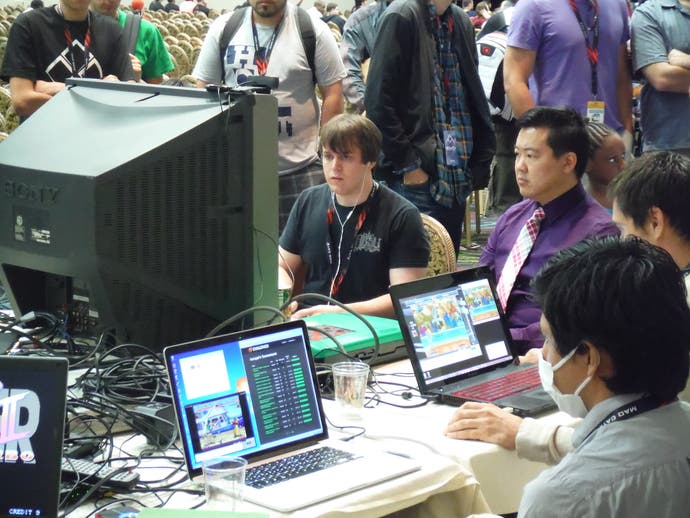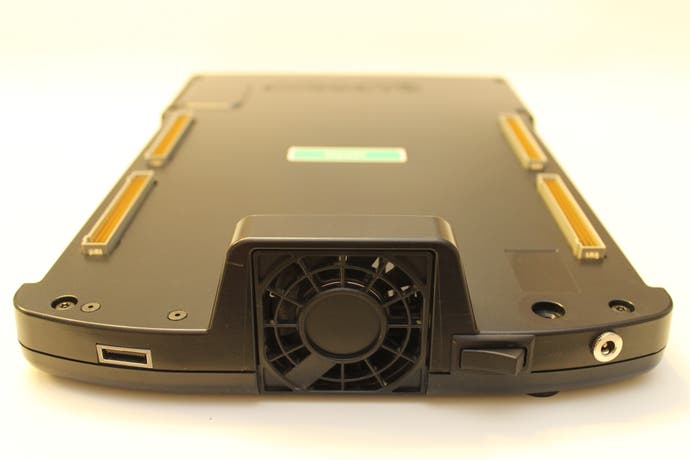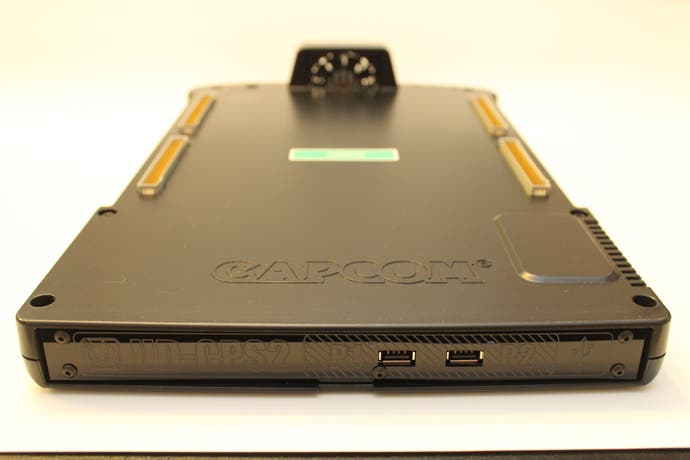Meet the console which brings Capcom's golden era to your living room
CPS2 gaming on your television.
Capcom may be famous these days for its gargantuan Resident Evil and Monster Hunter franchises, but it has been one of the industry's key players since the glory days of the 80s, tirelessly pumping out solid-gold classics like Bionic Commando, Mega Man, Black Tiger, 1942, Ghosts 'n Goblins, Final Fight and Strider years before Chris Redfield and Jill Valentine had their first unfortunate encounter with a slavering zombie in Spencer Mansion.
Capcom - like fellow Japanese publishers Taito, Konami and Namco - excelled in the coin-op realm when coin-ops still mattered, and benefitted greatly from the dominance of the Nintendo Famicom in its homeland. When that particular console morphed into the NES and made the jump to western shores, it turned these same companies - and the games they created - into instantly recognisable household names. However, it would be the release of Street Fighter 2: The World Warrior in 1992 that elevated Capcom to an entirely different level to its peers; one of the most commercially successful coin-ops of all time - and an equally profitable domestic property on a wide range of home systems - this seminal release triggered a public frenzy for one-on-one fighters which would continue unchecked for the best part of the decade and would establish Capcom as one of Japan's most prolific game-makers.
Much of this success was laid down by Capcom's dedicated hardware team, which came up with its own arcade hardware. The first CP System powered such coin-guzzling classics as Final Fight, Captain Commando and Street Fighter II, but 1993's CPS2 was a marked improvement and would be Capcom's go-to arcade board until the much-hyped arrival of CPS3 in 1996. CPS2 would be supported for an entire decade - the final game was 2003's Hyper Street Fighter 2: Anniversary Edition - and played host to some of the finest 2D competitive fighting games ever created.

Given its illustrious history and fine catalogue of titles - which includes the likes of X-Men vs. Street Fighter, Vampire Savior: Lord of the Vampire, Mars Matrix, Aliens vs. Predator, Progear, Marvel vs. Capcom and Street Fighter Alpha 3 - it's little wonder that seasoned Capcom fans are seeking ways to keep the CPS2 legend alive - something which is made increasingly difficult by the fact that boards are rising in value, arcade cabinets are expensive to maintain and bulky to store, and - possibly most importantly of all - CPS2 boards feature built-in "suicide batteries" which, when totally depleted of charge, render the game entirely useless.
This was Capcom's attempt to beat arcade bootleggers who impacted profitability so dramatically during the CPS1 era; the battery powers a portion of memory which contains the top-secret encryption keys required for games to run. What Capcom didn't anticipate - or perhaps didn't care about - was future collectors having to contend with their library of hard-earned boards becoming unplayable, and this presents a unique problem to CPS2 enthusiasts today. The batteries have to be replaced before they fail because the moment they do, the memory is wiped and the encryption keys are permanently lost. Welcome to the wild and wacky world of CPS2 collecting.
Despite the odds being very much against them, collectors have created a small yet robust sector of the retro gaming community that is fiercely determined to ensure that CPS2 titles can always be played in their original form. One such fan is Brian 'Undamned' Grissom, who has used his impressive grasp of technology to create a 'consolised' CPS2 arcade system which can be plugged directly into your television and controlled using readily-available Xbox 360 or PS3 controllers. Hailing from the backwaters of North America, Grissom used his love of electronics to escape the relative seclusion of his formative years.
"I grew up in a rural farming area, but I've been interested in electronic toys and gizmos for most of my life," he says. "After high school it made sense to pursue a proper education in electronics so I moved away from home and did just that. I was hired right out of college by a small industrial automation company to do hardware and firmware design, and have been there for almost 15 years."
A keen gamer, Grissom kept abreast of developments in the hardware modding community, starting with one of the earliest examples of user-created modifications. "The first console mods that really interested me were the RGB video mods that people were doing to get the absolute best picture quality out of their old game consoles," he explains. "I played around with that stuff and also some controller hacks, but nothing really impressive." A long-time fan of Capcom's CPS2 range of titles, Grissom's interest in tackling a more challenging project was piqued after listening to the Wakeip SRK podcast, which focuses on the competitive fighting game scene and is run by Damien 'Damdai' Dailidenas and Chris 'Galeo' Hatala. The passion these two individuals had for classic 2D fighters - and ensuring that they remained part of the competitive scene despite their advanced years - impressed Grissom immensely.

"It was very clear after listening to both of them that there were still some players with a strong desire to keep arcade perfect CPS2 games present at tournaments, but that the logistics of running arcade cabinets was a headache for organisers," he says. "I share their passion for playing these games in their truest form and keeping those scenes alive, so being as I have some technical know-how, it just seemed fitting for me to try to work out a solution."
The solution is the UD-CPS2, which takes the guts of a standard CPS2-powered arcade system and lovingly places them inside something which acts more like a typical home console. "I wanted everything plugging into the system to be as standard as possible," Grissom explains. "The three key elements to run an arcade game on your TV are a power source, video output and controller input. For a power source, I designed a small power converter that goes inside the system to allow it to run off of a large variety of standard laptop chargers. For video output, I wanted to go with an interface for which cables were still readily available, so I designed a video converter to go inside which uses the standard Playstation AV port - supporting Composite, S-Video, RGB and Left/Right audio. For controller inputs, I went with what was most prevalent at the time - Xbox 360 and PS3." Each system takes around four hours to create, and Grissom says that he has been inundated with requests.
It's tempting to ask exactly what makes the CPS2 so special that people are willing to hand over the $400 Grissom asks for to create this unique hardware. For Grissom, CPS2 is perhaps the pinnacle of the 2D arcade artform, and he feels that some of the best titles to use the board have never been surpassed, even after all this time. "There are many titles on CPS2 that are brilliant specimens of their respective forms," he says. "For example, CPS1 Final Fight was to belt-scroll action games what CPS1 Street Fighter 2 was to fighting games: revolutionary. And yet CPS2 Alien vs. Predator manages to surpass Final Fight, a near perfect execution of the genre. The same can be said for CPS2 Super Street Fighter 2 Turbo. Even with some of it's broken elements, it is to this day one of the greatest entries in the Street Fighter franchise. Vampire Savior is practically a college course in 2D sprite work and animation. The Marvel crossover fighters took the grandeur of superhero action that was confined to comic books and cartoons and brought it to digital life with giant sprites and full screen chaos as never seen before in video games."
The quality of these games is clearly not in doubt, but why go to the bother and cost of buying a dedicated system - not to mention equally expensive games - when you can just emulate CPS2 via MAME? The encryption codes were cracked way back in 2001, and even a reasonably-powered Android smartphone is capable of running pretty much every CPS2 title at near full-speed. So why bother? "I'm guessing emulation on most of those titles is at least 95 per cent accurate, so I realistically would probably never notice the difference, but there's just something special about running games in their native form. It's the same argument most game collectors would have for owning various cartridge collections rather than a hard drive full of ROMs."
However, for Grissom the most pressing reason to avoid emulation is the competitive tournaments that compelled him to create his consolised CPS2 in the first place. "From a tournament standpoint, competing on something other than the original hardware - or at least an officially released port of a game - is considered 'unprofessional' and many event coordinators won't even allow it," he says. "Competition is based on rules and standards and at this point in time, unlicensed emulation falls outside of that." To the people who run such events, Grissom's work is a godsend. "As much as I'd hoped it would be received well, I wasn't prepared for it to be welcomed with such open arms," he comments. "Using it for the ST Games at EVO 2013 brought a lot of interest, including from international players. There are now UD-CPS2s in Germany, Brazil, UK, Chile, Canada, France, Australia and Japan. The 'arcade cabinet only' mentality runs deep in Japan, so it was a huge vote of confidence for them to be willing to use my systems."

As accomplished as Grissom's machine unquestionably is, it's far from being the finished article in his eyes. A consummate perfectionist, his mind is overflowing with potential improvements and augmentations, but he's managed to narrow them down to three key areas. "The first would be to retain the JAMMA edge connector - the interface that connects to the wiring inside of an arcade cabinet - on the front of the system," he says. "When I first set out to consolise the CPS2, retaining the ability to hook it up to an arcade cabinet was not even on my radar. After some thought, I've concluded that it would indeed be nice to have a hybrid system which could run in an arcade cabinet and then, when you want to take it to an event or a friend's house, you can just unplug it and go. The second point would be to add HDMI video output. Though more manageable than lugging arcade cabs to an event, getting heavy-tube televisions to an event is still a pain. To truly make UD-CPS2 as simple to use as the other consoles at gaming tournaments today, it really needs HDMI and the CPS2 already has the raw digital colour, timing and audio data available to have an add-in board that reads that data and produces a lag free digital connection for modern displays. Thirdly, there is almost always room to improve firmware, so I aim to continue to add features and support for more game controllers, including PS4 and Xbox One."
The UD-CPS2 isn't the only Capcom related technical marvel that Grissom has been working on. Mindful of the fact that there already exists an industrious army of modders who have lovingly built their own systems, he's created a unique bolt-on interface - called the UD-USB Decoder - which has proven to be invaluable on the competitive circuit. "It's basically the same Xbox 360/PS3 controller interface used for the UD-CPS2, but in a discrete package so that people can either integrate them into their own electronics project - like making an adapter to use your Xbox 360 controller on your NES, for example - or simply plug them straight into their existing supergun or consolised system, such as an Atomiswave or Neo Geo MVS," he explains. "We used some of them at EVO 2014 and the players loved them. They were attached to the head-to-head arcade cabinet stations so that people could either use the normal arcade controls or plug in their own personal Xbox 360/PS3 controller. I thought for sure that hardly anyone would use them - seeing as the actual arcade control panel is sitting right there - but to my pleasant surprise, they were used by probably half of the players."
The arrival of Grissom's UD-CPS2 system is well timed, as demand for Capcom's classic arcade titles appears to be on an upward curve. "CPS2 game prices are the highest they've ever been," he says. "Back when I first started collecting arcade stuff, games like Super Street Fighter 2, X-Men: Children of the Atom and Street Fighter Alpha were 'commons' and could be had for around $20 on eBay. Now those titles probably average $75. Games like Super Street Fighter 2 Turbo now command $300, whereas they used to be less than $100. There are still plenty of 'middle of the road' titles that can be had for less than $100, but much like retro-game collecting at large, these are expensive times."
Rising prices may suggest increasing interest, but is there really a long-term market for people collecting CPS2 titles when you consider that the games are akin to ticking time bombs, ready to die when their internal batteries fail, thereby wiping out your hefty investment? Mercifully, dedicated fans have already solve this irksome problem. Dead CPS2 titles can not only be revived, but also placed in a state where failing batteries are no longer a pressing concern.
"There is no way to fully restore original factory encryption code after death," Grissom says. "The means of resurrecting dead boards is by replacing the encrypted program files in some chips with decrypted program files. It requires removing and reprogramming some chips on the game board. The original source for reprogramming these chips was Razoola of CPS2Shock. You send him some specific chips and he'll send them back with his 'Phoenix Edition' files loaded and ready to put back into your game. More recently, Team Avalaunch created their own files which are free to download, but you need to program the chips yourself." Overcoming this hurdle is great news for those who want to keep their CPS2 titles alive, but it can have ramifications for certain sectors of Capcom fandom. "From a collector's standpoint, there are many who see resurrected games as not 100 per cent pure since the program files have been altered, and though plagued with swapping batteries every few years, hold fast to keeping the games in their original form," Grissom states. "I personally don't mind resurrected games, though I do try and keep the ones that do have batteries alive as long as I can."
There are many ways to scratch that retro-gaming itch; you can search eBay for a dusty and battered SNES or trawl local charity shops in the hope of picking up some inexpensive Mega Drive games. A cheaper - and perhaps more dubious option - is to emulate classic systems on your PC, smartphone or tablet. However, investing in a UD-CPS2 and shelling out bundles of cash for CPS2 games - then facing the prospect of having to pay additional money to ensure the titles remain in a playable state - is unquestionably at the top end of the commitment scale. Grissom has created a custom console which is not only the toast of the competitive one-on-one fighting game circuit, but also the dream platform for those who fondly recall jamming handfuls of loose change into some of the 90s most alluring and compelling arcade classics. "The demand has been overwhelming, way more than I can keep up with," he says. "I just take down people's names and work my way through the ever-growing list. The feedback from buyers has been great. It's not like a new console where you hope good games will come out for it; people have a full understanding of why they are buying the system and they love the simplicity."


